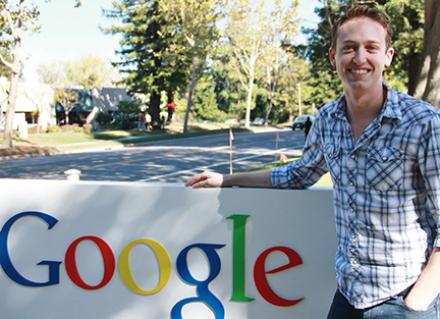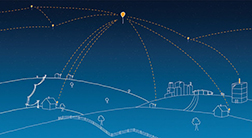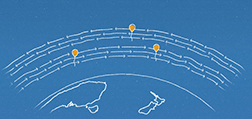Up and Away

More than a million people apply each year for jobs at Google. Of these, only a miniscule half of one percent reportedly are hired by the tech giant, named “the best company to work for” by Fortune Magazine for the past five years.
So when Doug Wightman (BCom’04, PhD’13-Computer Science) caught the eye of a Google VP and was offered a job there, he accepted. How could he resist working at a company described on Fortune’s website by a Google employee as, “a cross between Harvard, Hogwarts and NASA”?
Within months of his arrival, Doug was consulting on Google X projects at the top-secret Google X innovation lab at the company’s main campus in Mountain View, California. It’s the home of such technological breakthroughs as the driverless car and Google Glass, a wearable Android device that displays information in the user’s field of vision. These are the devices of the future, being created today by multidisciplinary teams tasked with coming up with the next big thing. “X is focused on transformative change,” Doug explains. “We’re aiming to improve technologies by a factor of ten. If you’re thinking big enough about the really hard problems, incremental progress in smaller steps rarely provides the solution.”
The really hard problem Doug and his colleagues are tackling now is how to bring Internet access to the two-thirds of the world’s population that isn’t yet connected. Google’s answer is a network of balloons, travelling on the edge of space, to connect people in rural and remote areas to the Internet, and to bring people back online after disasters. Project Loon, “Balloon- Powered Internet for Everyone,” launched in June 2013, with test flights in California and, later, in remote regions of New Zealand and Brazil. Doug has been in the thick of it, responsible for planning, simulation and control of test flights, as well as predicting and guiding balloon movements. “It’s pretty exciting stuff,” says Doug, with considerable understatement.
It’s also a perfect fit for someone with an eclectic background and a highly curious intellect. As a high school student in Kingston, Doug excelled academically. So much so that while in Grade 10, he took second-year computer science, linear algebra and economics courses at Queen’s, and was able to graduate from high school a year early. The opportunity to complete both Commerce and BSc (Computer Science) degrees concurrently made the decision to study at Queen’s an easy one, says Doug. His longstanding family ties to the university didn’t hurt — his parents, Mary-Jean McIntyre (BSc’79, Chemical Engineering) and Thomas Wightman (BCom’76), grandparents and even a great-grandfather, all attended Queen’s.
A Google employee’s description of the company: “a cross between Harvard, Hogwarts and NASA.”
An MSc in computer science at Stanford University in California followed. There Doug became one of the first alumni of the school’s renowned “d.school”, a program designed for multidisciplinary teams from various faculties to “foster radical collaboration” and “prepare future innovators to be breakthrough thinkers and doers.” Stanford was another great fit for the computer scientist/entrepreneur who launched three start-ups during his student days. MotionSketch, which he started at Queen’s and continued while at Stanford, provided motion-sensing and text-messaging technologies to interact with public displays. “We developed novel interaction techniques and partnered with advertising firms to build and deploy installations across Canada and the U.S. for such clients as Nokia and Jack Daniel’s,” Doug explains. A second venture, Xuuk, produced eye-tracking hardware and intellectual property, and SxCheck offered patient-accessible electronic medical records.
When confronted with the “What’s next?” question after his Stanford graduation, Doug decided to return to Kingston. “My long-term girlfriend, Melissa Raby (BNSc’04, MPA’05), was still living in Kingston,” says Doug. “I was also working on a deal to sell SxCheck to a Canadian company. I decided to return to Kingston and convince Melissa to marry me.” That’s exactly what happened. “I started my PhD in computer science at Queen’s for something to do and as an excuse to spend more time thinking about problems that intrigued me.” He and Melissa were married in 2009 and Doug graduated with his PhD in 2013.
It was his PhD research on search-based programming interfaces (“Basically, making programming easier by incorporating search functions,” Doug explains) that caught the eye of that Google VP and led to Doug being hired in November, 2012.
Doug doesn’t see moving to Google as a shift away from his entrepreneurial interests. “I think of businesses as being vehicles to answer questions about the world. Each is an ongoing experiment, testing hypotheses by attempting to serve customers in various ways. I had specific hypotheses in mind for each of the companies I co-founded. Right now, the questions I’m looking to answer are easiest to tackle from within Google.”
 Doug Wightman
Doug Wightman
His first role at Google was to build on his PhD research, but within several months of his arrival he switched gears to design a prediction system using a unique and previously untapped data set. From early on, he consulted on several Google X projects, including designing an app for Google Glass.
Doug switched to the Project Loon team full-time in 2014. He was attracted to the project, not only because of the audacity of its goal and world-changing implications, but also because the project is led by Mike Cassidy, an inspirational mentor from Doug’s Stanford days. Doug quotes a famous saying of Mike’s that applies to his small Project Loon team: “If you move twice for every move your opponent makes, you can beat a grandmaster at chess.”
While Google is famous for its employee perks, including free gourmet meals, nap pods and guest presentations by the world’s thought-leaders, the freedom to do what you want tops Doug’s list of what makes Google special. “It’s pretty easy to justify working on just about anything that might interest you, since most software advances would have a significant impact for Google,” Doug explains.
He’s equally energized by the work environment. “Ideas spread like wildfire,” he says. “Desks are covered with sketches, models, prototypes and research papers. Teams are small and nimble and the rate of progress is astounding. Sometimes I run up the stairs really fast after a meeting to burn off a little of the excitement so that I’ll be able to focus when I get back to my desk.”
He plans to stay with Project Loon for the foreseeable future. “I like the start-up feel of the team and there are many exciting problems to solve,” Doug says. “Perhaps most importantly, bringing the Internet to parts of the world that have been left behind is something I really want to see happen.”
It’s a sentiment that corroborates his personal philosophy: “If each year is roughly a percent of your life, you might as well try to make the best use of each one.”
Check out Google’s Project Loon website at google.com/loon for more information, including videos and photos.



